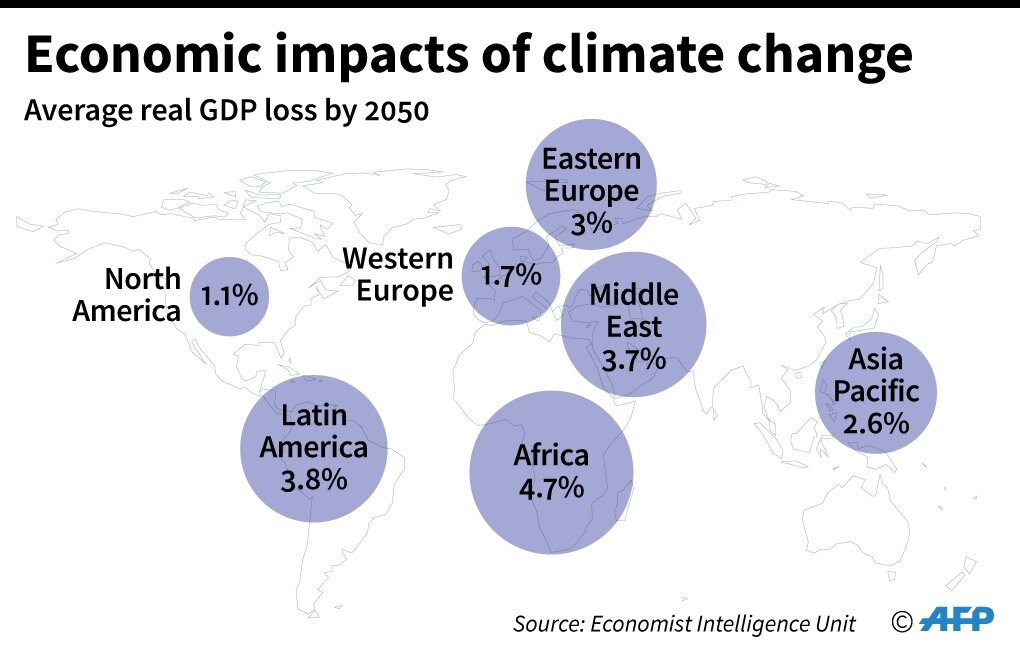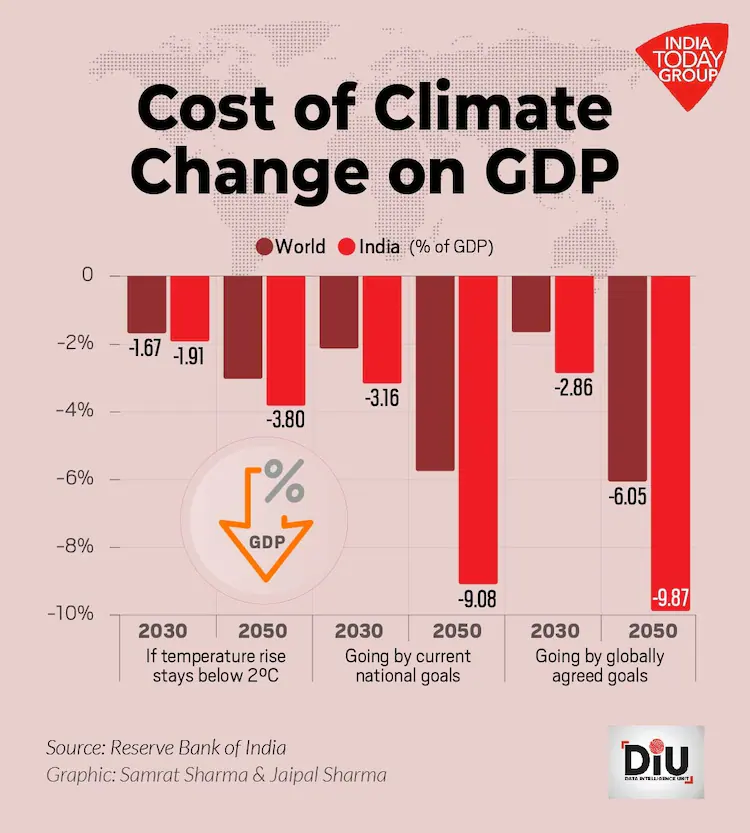Indian Economy
Economic Ripples of Climate Change
This editorial is based on “The growing cost of climate change” which was published in The Indian Express on 23/05/2024. The article brings into picture the rising economic impacts of climate change and need for mitigation as well as adaptation measures.
For Prelims: Climate change, Geoeconomic landscape, Extreme weather events, Nile River basin, Arctic Sea Ice Melting, Climate Gentrification, Reserve Bank of India, National Action Plan on Climate Change , Panchamrit Commitments, Green Hydrogen Mission
For Mains: Economics of Climate Change in India, Impact of Climate Change on Global Economic Landscape.
Climate change is transforming the global geoeconomic landscape, and its mounting economic tolls can no longer be disregarded. Two recent studies have sounded alarms- one by the US National Bureau of Economic Research estimates the world's GDP would be 37% higher today without global warming since 1960, while another in Nature projects average incomes could plummet by nearly a fifth in the next 26 years due to climate impacts.
- Global climate policy has rightly focused on mitigation, but adaptation remains underfunded despite growing awareness of its need. Investing in resilience against climate change is not just an environmental imperative but an economic necessity for safeguarding sustainable development.
How Climate Change is Shifting Global Geoeconomic Landscape?
- Shifting Agricultural Patterns: Rising temperatures, changing precipitation patterns, and extreme weather events are altering the geographic distribution of suitable areas for agriculture.
- For instance, declining crop yields in traditionally fertile regions like the Middle East and North Africa due to drought and desertification are leading to increased food insecurity and potential economic instability.
- Resource Scarcity: Climate change is exacerbating water scarcity, leading to conflicts over shared water resources.
- The Nile River basin, shared by several African countries, is facing increasing tensions as water levels fluctuate due to climate change, impacting agriculture, hydropower, and economic activities.
- Migration and Displacement: Climate-induced events are forcing people to migrate from their homes, creating economic challenges for host communities and potential conflicts over resources.
- For example, according to the Natural Resources Defense Council, rising sea levels will submerge around 17% of Bangladesh's coastal lands and displace about 20 million people by 2050.
- Erupted Arctic Economic Opportunities: The melting of Arctic sea ice is opening up new shipping routes and access to natural resources, leading to a potential economic race among nations with interests in the region.
- For example, Russia has been investing in developing its Northern Sea Route for commercial shipping, while countries like China and India are exploring economic opportunities in the region.
- Climate-induced Conflicts: Climate change is acting as a "threat multiplier," exacerbating existing tensions and conflicts over resources, particularly in regions already facing political instability and economic challenges.
- Climate-related Supply Chain Disruptions: Extreme weather events and climate-induced disasters can disrupt global supply chains, leading to economic losses and potential shortages of critical goods.
- For example, the 2011 floods in Thailand, a major manufacturing hub for electronics and automotive parts, caused widespread supply chain disruptions and economic impacts globally.
- Climate Gentrification: As certain regions become more susceptible to climate change impacts, such as rising sea levels or extreme weather events, there is a risk of "climate gentrification," where wealthier individuals and businesses relocate to areas deemed safer or more resilient.
- This could lead to economic displacement and further marginalization of vulnerable communities.
What are the Major Impacts of Climate Change on the Indian Economy?
- Reduced Agricultural Productivity and Yield: Climate change can severely disrupt crop cycles and cause low agricultural yield.
- Agriculture is the primary source of livelihood for around 55% of India’s population and contributes significantly to the economy.
- Low yields can hit the rural economy and push inflation in urban areas.
- For instance, in absence of adoption of adaptation measures, rainfed rice yields in India are projected to reduce by 20% in 2050.
- Setback to Industrial and Service Sector: There could be an increase in operational costs and a reduction in profits in the industrial sector.
- Reasons include imposition of new climate-friendly regulations, reduced utilization of old stock, and diversion of investment towards greener infrastructure.
- Relocation of production processes and activities due to climate-related losses can also add to economic loss.
- Also, increased insurance claims and disruptions in travel and hospitality can pose multiple threats to the service sector.
- Reasons include imposition of new climate-friendly regulations, reduced utilization of old stock, and diversion of investment towards greener infrastructure.
- Infrastructure Damage: Extreme weather events induced by climate change like floods and heatwaves can significantly damage infrastructure.
- For instance, India spent USD 3 billion of economic damage caused by floods in the last decade which is 10% of the global economic loss.
- Labor Market Impacts: Climate induced health hazards could lead to a loss in productivity and cause migration from areas more prone to climate risks.
- The Reserve Bank of India (RBI) estimates that up to 4.5% of India's GDP could be at risk by 2030 due to lost labor hours from extreme heat and humidity.
- It is estimated that India could account for about 3.4 crore (34 million) of the projected 8 crore (80 million) global job losses from heat stress by 2030.
- Risks for Banks and Financial Institutions: The RBI classifies risks from climate change into physical risks (extreme weather events, temperature shifts, etc.) and transition risks (credit, market, liquidity, operational, and reputational risks).
- These risks can have direct, indirect, and spillover effects (intra-economy, cross-border impact, or contagion risks) on banks and financial institutions.
- Impacts on High-Emission Industries: Industries like electricity production, metal products production, transportation, and mining cause maximum greenhouse gas emissions.
- The RBI notes that in India, about 40% of current annual carbon emissions could be addressed by replacing fossil fuels with renewables, and another 15% by switching to electric vehicles and energy-efficient electrical appliances.
- However, the remaining 45% relate to hard-to-abate sectors like heavy industries, animal husbandry, and agriculture.
- The RBI notes that in India, about 40% of current annual carbon emissions could be addressed by replacing fossil fuels with renewables, and another 15% by switching to electric vehicles and energy-efficient electrical appliances.
What are the Key Initiatives India has Undertaken to Tackle Climate Change?
- National Action Plan on Climate Change
- National Solar Mission
- National Mission for Enhanced Energy Efficiency
- National Mission on Sustainable Habitat
- National Water Mission
- National Mission for Sustaining the Himalayan Ecosystem
- National Mission on Strategic Knowledge for Climate Change
- National Mission for a Green India
- National Mission on Sustainable Agriculture
- Panchamrit Commitments
- Green Hydrogen Mission
What Measures Should be Adopted to Mitigate the Impacts of Climate Change on the Indian Economy?
- Exploring Industrial Symbiosis: India should revolutionize the circular economy model, which focuses on minimizing waste, reusing materials, and regenerating natural systems.
- The Indian government can incentivize companies to adopt circular business models, such as product-as-a-service or industrial symbiosis, where one industry's waste becomes another's raw material.
- Foster Public-Private Partnerships for Green Innovation: India can encourage public-private partnerships (PPPs) to accelerate the development and deployment of green technologies and solutions.
- The government can establish a dedicated fund or incubator to support startups and companies working on innovative climate change mitigation and adaptation technologies, such as carbon capture and storage, renewable energy storage, or drought-resistant crop varieties.
- Promote Climate-Conscious Urban Planning: India should prioritize climate-conscious urban planning to create sustainable and resilient cities.
- The Indian government's Smart Cities Mission can be linked with India's National Action Plan on Climate Change to include specific climate change adaptation and mitigation measures.
- Develop Climate-Resilient Special Economic Zones (SEZs): India can create climate-resilient SEZs that prioritize sustainable practices and green infrastructure.
- These zones could attract businesses and industries that are committed to reducing their carbon footprint and enhancing resilience.
- Masdar City in the UAE, which is a planned eco-city, can be a significant role model.
- Develop a National Green Taxonomy: India can establish a national green taxonomy, which is a classification system that defines environmentally sustainable economic activities.
- This taxonomy can guide investments, lending decisions, and policy interventions towards sectors and projects that contribute to climate change mitigation and adaptation.
- The European Union sustainable finance taxonomy can be a significant model.
- Green Bond Financing for Infrastructure: India can accelerate issuing sovereign green bonds to attract domestic and international capital for building climate-resilient infrastructure.
- These funds can be used for flood-resistant embankments, heat-resistant buildings, and renewable energy projects.
|
Drishti Mains Question: Examine the economic impacts of climate change and how they are transforming the global geoeconomic landscape. Highlight key sectors affected. |
UPSC Civil Services Examination, Previous Year Question (PYQ)
Prelims
Q.1 In the context of India’s preparation for Climate-Smart Agriculture, consider the following statements: (2021)
- The ‘Climate-Smart Village’ approach in India is a part of a project led by the Climate Change, Agriculture and Food Security (CCAFS), an international research programme.
- The project of CCAFS is carried out under Consultative Group on International Agricultural Research (CGIAR) headquartered in France.
- The International Crops Research Institute for the Semi-Arid Tropics (ICRISAT) in India is one of the CGIAR’s research centres.
Which of the statements given above are correct?
(a) 1 and 2 only
(b) 2 and 3 only
(c) 1 and 3 only
(d) 1, 2 and 3
Ans: (d)
Q.2 Which of the following best describes/describe the aim of ‘Green India Mission’ of the Government of India? (2016)
- Incorporating environmental benefits and costs into the Union and State Budgets thereby implementing the ‘green accounting’.
- Launching the second green revolution to enhance agricultural output so as to ensure food security to one and all in the future.
- Restoring and enhancing forest cover and responding to climate change by a combination of adaptation and mitigation measures.
Select the correct answer using the code given below.
(a) 1 only
(b) 2 and 3 only
(c) 3 only
(d) 1, 2 and 3
Ans: (c)
Q.3 With reference to ‘Global Climate Change Alliance’, which of the following statements is/are correct? (2017)
- It is an initiative of the European Union.
- It provides technical and financial support to targeted developing countries to integrate climate change into their development policies and budgets.
- It is coordinated by World Resources Institute (WRI) and World Business Council for Sustainable Development (WBCSD).
Select the correct answer using the code given below:
(a) 1 and 2 only
(b) 3 only
(c) 2 and 3 only
(d) 1, 2 and 3
Ans: (a)
Mains
Q.1 Describe the major outcomes of the 26th session of the Conference of the Parties (COP) to the United Nations Framework Convention on Climate Change (UNFCCC). What are the commitments made by India in this conference? (2021)
Q.2 ‘Climate Change’ is a global problem. How will India be affected by climate change? How Himalayan and coastal states of India be affected by climate change? (2017)






